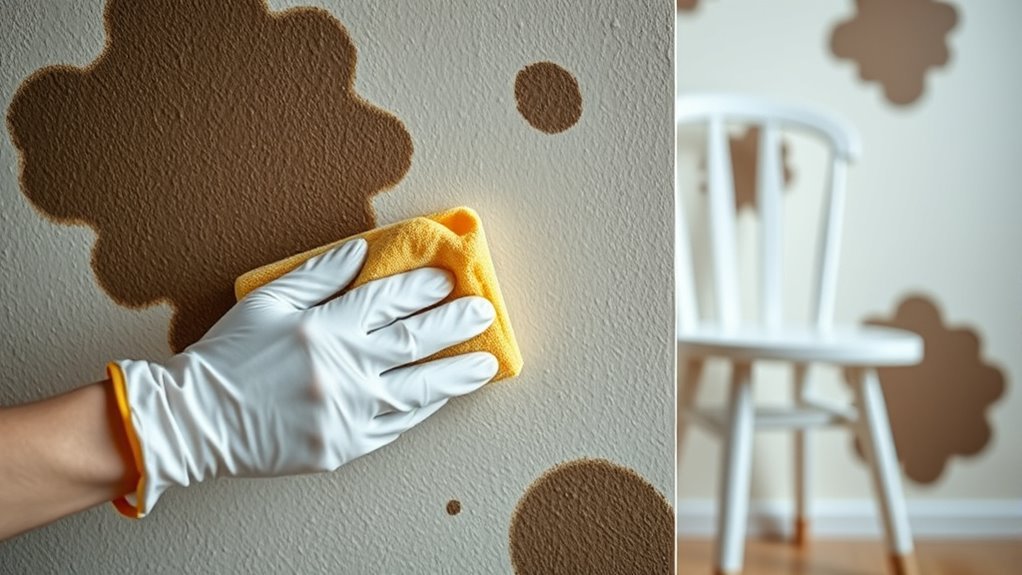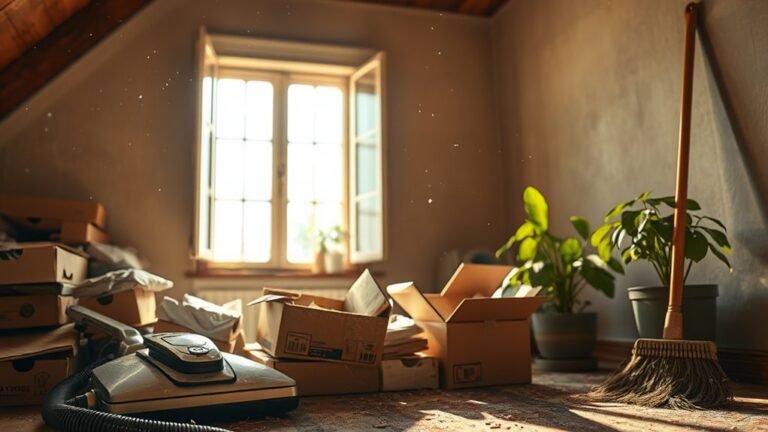Removing Chair Stains From Walls
To remove chair stains from your walls, first identify your wall type and stain kind—drywall, plaster, or wood, and whether the stain is greasy or chalky. Start with household solutions like a vinegar-water mix or baking soda on a damp cloth, testing a small spot to avoid damage. For tougher marks, use commercial cleaners safely, respecting product instructions. Prevent future stains with wall guards or chair placement. Keep going to explore tips for delicate surfaces and when to call in pros.
Identifying the Type of Wall and Stain

Before you can effectively remove chair stains from your walls, you need to identify both the wall type and the stain’s nature. Start by examining the wall materials—common types include drywall, plaster, wood paneling, and textured surfaces. Each demands a different cleaning approach to avoid damage. Next, assess the stain characteristics. Is the stain greasy, chalky, or water-based? Greasy marks often come from oils or dirt, while chalky stains might indicate paint residue or chalk dust. Water-based stains could be from liquids or mildew. Pinpointing these details guides your stain removal method, ensuring you choose the right cleaning solution without harming your walls. Understanding wall materials and stain characteristics gives you the freedom to tackle the problem confidently and efficiently.
Using Household Items to Remove Stains
When tackling chair stains on your walls, you don’t need specialized cleaners—common household items often do the trick effectively. Start by making a gentle vinegar solution: mix equal parts white vinegar and water in a spray bottle. Lightly mist the stained area, then wipe with a soft cloth. For tougher marks, sprinkle baking soda directly on a damp cloth and gently rub the stain in a circular motion. Baking soda acts as a mild abrasive, lifting grime without damaging paint. Afterward, wipe the wall with a clean damp cloth to remove residue. Always test these methods on a small, hidden spot first to guarantee your wall finish remains intact. Using these simple, natural ingredients lets you remove stains efficiently while keeping your space chemical-free and fresh.
Applying Commercial Cleaning Products Safely

Although household items work well for many stains, tougher chair marks may require commercial cleaning products. Before you start, check the product compatibility with your wall’s paint or finish to avoid damage. Always test a small, hidden area first. Follow safety precautions by wearing gloves and ensuring good ventilation. Avoid mixing products to prevent harmful reactions. Apply the cleaner gently with a soft cloth or sponge, working from the outside of the stain inward to prevent spreading. Rinse the area with clean water afterward and dry it thoroughly. By taking these steps, you’ll effectively remove stubborn stains without risking harm to your walls or yourself, keeping your space fresh and stain-free with confidence.
Preventing Future Chair Stains on Walls
To prevent future chair stains on your walls, consider installing protective wall guards where chairs frequently contact surfaces. Keeping up with regular cleaning will also help minimize buildup before stains set in. These simple steps can save you time and effort in maintaining clean walls.
Use Protective Wall Guards
Protect your walls by installing protective wall guards behind chairs that frequently come into contact with them. These guards act as a barrier, preventing scuffs and stains caused by regular use. When choosing wall protection, opt for clear or color-matched guards to maintain your room’s aesthetic. Proper furniture placement also plays a role; position chairs with enough clearance to minimize contact with walls. Measure the space carefully before installation to guarantee the guards cover the most vulnerable areas. Wall guards are easy to install with adhesive backing or screws, providing durable, long-lasting protection. By combining strategic furniture placement with protective wall guards, you’ll maintain clean walls and reduce the need for frequent touch-ups, giving you more freedom to enjoy your living space without constant worry about damage.
Regular Cleaning Maintenance
Installing wall guards and arranging furniture thoughtfully can greatly reduce chair stains on your walls, but keeping them spotless requires ongoing attention. To prevent future marks, commit to regular cleaning as part of your maintenance routine. Wipe down walls with a damp cloth weekly to catch dirt and scuffs early. Use mild soap solutions for tougher spots, ensuring you don’t damage paint finishes. Check chair backs and wall guards for wear, replacing or adjusting them as needed. Avoid pushing chairs directly against walls by creating a small gap, limiting contact. These maintenance tips help preserve your walls’ appearance and extend the life of protective measures. By staying consistent, you’ll enjoy stain-free walls without sacrificing your freedom to arrange furniture as you please.
Tips for Cleaning Delicate or Painted Surfaces

How can you effectively remove chair stains from delicate or painted walls without causing damage? Start by testing a mild cleaner on a small, hidden area to verify it won’t harm the painted finishes. Use a soft cloth or sponge dampened with a gentle solution—like diluted dish soap or a mixture of water and white vinegar—to gently blot the stain. Avoid scrubbing, which can damage delicate surfaces or strip paint. Work slowly, rinsing the cloth frequently to prevent spreading the stain. For stubborn marks, try a magic eraser on the lowest setting, but test first. Always dry the area immediately with a clean, soft towel to prevent moisture damage. This careful approach lets you clean effectively while preserving the integrity of your walls.
When to Call a Professional Cleaner
If you notice stains that won’t come off despite your best efforts, it might be time to call a professional cleaner. Professionals have specialized tools and products that can safely remove tough marks without damaging your walls. Knowing when to seek their help can save you time and prevent further issues.
Identifying Stubborn Stains
When should you consider calling a professional cleaner for chair stains on your walls? It’s essential to identify stubborn stains that resist your usual cleaning efforts. Certain stain types and stain sources can be particularly challenging, signaling it’s time for expert help. Look out for:
- Deeply ingrained marks from oils, dyes, or ink that don’t fade after gentle scrubbing
- Stains caused by chemical reactions or paint damage that worsen with DIY attempts
- Areas with mold or mildew linked to moisture, which require specialized treatment
Benefits of Professional Help
Recognizing stubborn stains is just the first step; knowing when to bring in a professional can save you time and prevent further damage. If your chair stains have deeply penetrated the wall or DIY methods haven’t worked, calling a professional cleaner makes sense. Experts use specialized tools and expert techniques that effectively remove tough stains without harming your wall’s surface. While it may seem like an extra expense, the cost benefits often outweigh the risk of costly repairs from improper cleaning. Professionals also offer quicker results, freeing you to focus on what matters most. When stains resist your best efforts or the wall material is delicate, relying on skilled help guarantees a clean, damage-free finish, giving you peace of mind and preserving your space’s appearance.
Frequently Asked Questions
Can Chair Stains Damage the Wall’s Structural Integrity?
You don’t need to worry much about chair stains damaging your wall’s structural integrity. Stains usually affect only the surface and don’t compromise the wall itself. When you focus on stain removal promptly, you prevent discoloration from setting in, which keeps your walls looking fresh. However, if the stain involves moisture or damage, addressing it early with proper wall repair guarantees your space stays solid and stain-free, letting you enjoy your freedom without hassle.
Are There Eco-Friendly Products to Remove Chair Stains?
You can definitely find natural cleaners for stain removal that are eco-friendly and effective. Look for products made from ingredients like vinegar, baking soda, or lemon juice—they’re gentle on surfaces and the environment. These natural cleaners let you maintain your space’s cleanliness without harmful chemicals, giving you freedom to care for your home responsibly. Just test a small area first to verify they work well on the stain and don’t damage the paint.
How Long Does It Take for Stains to Set on Walls?
Stains can be like shadows creeping across a sunlit wall, setting quickly if you don’t act. The time factors vary—some stains start bonding within minutes, while others take hours or days to fully set. To seize your freedom from permanent marks, prompt stain prevention is key. The quicker you address spills or scuffs, the less chance they have to embed themselves, keeping your walls looking fresh and unburdened.
Can Furniture Placement Reduce the Risk of Wall Stains?
Yes, furniture arrangement can definitely reduce the risk of wall stains. By positioning chairs and other furniture slightly away from the walls, you minimize direct contact, which helps prevent marks and scuffs. You can also add wall protection like bumpers or protective panels behind furniture. This way, you maintain your freedom to style your space without worrying about damaging your walls, keeping them cleaner and looking fresh longer.
Do Different Chair Materials Cause Different Types of Stains?
Like a fingerprint, different fabric types leave unique stain characteristics on surfaces. You’ll find that leather chairs tend to leave oily or dark marks, while synthetic fabrics might transfer dye or color. Natural fibers like cotton can absorb moisture, leading to water-based stains. Knowing this helps you choose cleaning methods wisely, giving you the freedom to maintain your space without damaging your walls or furniture.






